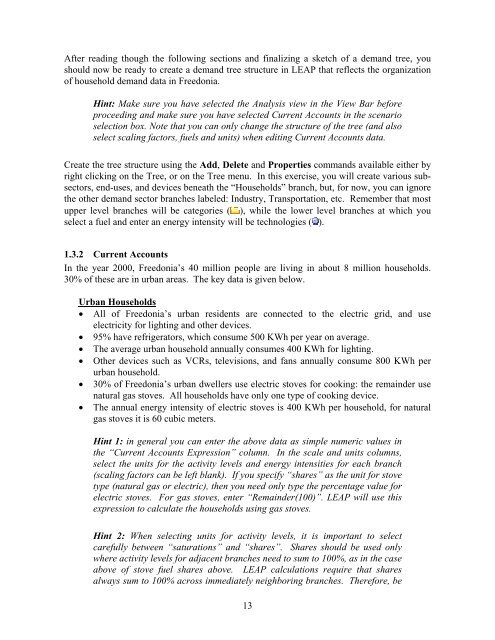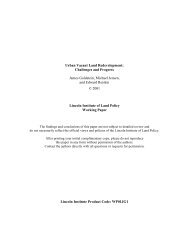training exercises - Tellus Institute
training exercises - Tellus Institute
training exercises - Tellus Institute
You also want an ePaper? Increase the reach of your titles
YUMPU automatically turns print PDFs into web optimized ePapers that Google loves.
After reading though the following sections and finalizing a sketch of a demand tree, you<br />
should now be ready to create a demand tree structure in LEAP that reflects the organization<br />
of household demand data in Freedonia.<br />
Hint: Make sure you have selected the Analysis view in the View Bar before<br />
proceeding and make sure you have selected Current Accounts in the scenario<br />
selection box. Note that you can only change the structure of the tree (and also<br />
select scaling factors, fuels and units) when editing Current Accounts data.<br />
Create the tree structure using the Add, Delete and Properties commands available either by<br />
right clicking on the Tree, or on the Tree menu. In this exercise, you will create various subsectors,<br />
end-uses, and devices beneath the “Households” branch, but, for now, you can ignore<br />
the other demand sector branches labeled: Industry, Transportation, etc. Remember that most<br />
upper level branches will be categories ( ), while the lower level branches at which you<br />
select a fuel and enter an energy intensity will be technologies ( ).<br />
1.3.2 Current Accounts<br />
In the year 2000, Freedonia’s 40 million people are living in about 8 million households.<br />
30% of these are in urban areas. The key data is given below.<br />
Urban Households<br />
• All of Freedonia’s urban residents are connected to the electric grid, and use<br />
electricity for lighting and other devices.<br />
• 95% have refrigerators, which consume 500 KWh per year on average.<br />
• The average urban household annually consumes 400 KWh for lighting.<br />
• Other devices such as VCRs, televisions, and fans annually consume 800 KWh per<br />
urban household.<br />
• 30% of Freedonia’s urban dwellers use electric stoves for cooking: the remainder use<br />
natural gas stoves. All households have only one type of cooking device.<br />
• The annual energy intensity of electric stoves is 400 KWh per household, for natural<br />
gas stoves it is 60 cubic meters.<br />
Hint 1: in general you can enter the above data as simple numeric values in<br />
the “Current Accounts Expression” column. In the scale and units columns,<br />
select the units for the activity levels and energy intensities for each branch<br />
(scaling factors can be left blank). If you specify “shares” as the unit for stove<br />
type (natural gas or electric), then you need only type the percentage value for<br />
electric stoves. For gas stoves, enter “Remainder(100)”. LEAP will use this<br />
expression to calculate the households using gas stoves.<br />
Hint 2: When selecting units for activity levels, it is important to select<br />
carefully between “saturations” and “shares”. Shares should be used only<br />
where activity levels for adjacent branches need to sum to 100%, as in the case<br />
above of stove fuel shares above. LEAP calculations require that shares<br />
always sum to 100% across immediately neighboring branches. Therefore, be<br />
13




